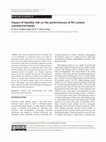Papers by Saroja Selvanathan

Economic Analysis and Policy, 2021
Abstract Financial inclusion (FI) is increasingly becoming a global policy priority because it en... more Abstract Financial inclusion (FI) is increasingly becoming a global policy priority because it enables access to financial services, such as savings, payments, risk management, and credit, to households and firms with a wide range of needs. However, to the best of our knowledge, no study has yet been undertaken on measures of FI and the nexus between FI and bank market structure in Africa. We used panel data from 17 African countries from 2004 to 2018 to measure FI and examine its nexus with bank market structure in these countries. We employed two-stage unsupervised machine learning to index FI: its dimensions in the first stage and overall FI in the second stage. Then, we employed an endogenous panel threshold model to examine bank market power and asset concentration impacts on FI. We found that bank market power enhances availability and accessibility dimensions but reduces the usage dimension. The impact of a higher regime market power on usage is worse than that of a lower regime market power. Asset concentration impacts on overall FI, availability, and usage are more pronounced under a lower regime concentration. The results imply that bank asset concentration and market power beyond thresholds are not desirable for promoting FI. The results also imply that scrutinizing potential sensitivity of the results to FI dimensions is vital.
Gold and the Modern World Economy, 2005

This insightful book analyzes the impact of Foreign Direct Investment (FDI) in China as well as m... more This insightful book analyzes the impact of Foreign Direct Investment (FDI) in China as well as making valuable contributions to the theory of FDI more broadly. The authors provide empirical analysis of key factors including the location-specific determinants of FDI; the impact of FDI on domestic investment, income distribution, consumption and tourism; the relationship between FDI inflows and income inequality; causality between FDI, domestic investment and economic growth; and causality between FDI and tourism. The study concludes that FDI plays a crucial and positive role in the economic development of China. Rather than crowding out domestic investment, FDI is found to stimulate economic growth by complementing it. China's Economic Miracle will be warmly welcomed by potential investors who are interested in investing in China. It will be highly useful for academics and postgraduate students with an interest in FDI or the Chinese economy. With strong policy-oriented analyses ...

Tourism Analysis, 2021
Following the end of the 20-year war against the US and its allies in 1975, Vietnam gradually ope... more Following the end of the 20-year war against the US and its allies in 1975, Vietnam gradually opened its doors in terms of market-oriented trade reforms in the late 1980s. The Vietnamese tourism sector simultaneously started to grow and, during the last decade, has shown rapid expansion with major contributors being countries who fought against Vietnam. However, very little scientific research has been published in relation to inbound tourism in Vietnam. This study aims to fill this gap by identifying the factors that attract tourists to Vietnam and analyzing to what extent the improved relationship with the West has impacted on its tourism sector. Our results indicate that the level of income of the travelers, the exchange rate of the country of origin, word of mouth from travelers, the relative price differential between the country of origin and Vietnam, and the normalization of relationship between Vietnam and the country of origin are the major determinants of demand for touris...

Applied Economics, 2016
This study investigates the impact of liquidity risk on the performance of commercial banks in Sr... more This study investigates the impact of liquidity risk on the performance of commercial banks in Sri Lanka by analysing secondary panel data of six systemically important banks in the Sri Lankan financial system from 2006 to 2016. The objective of this study is to identify the significant liquidity risk factors and the impact of them on both top line and bottom line performance indicators of commercial banks. Researchers find that liquidity gap and non-performing loan ratio are the significant proxies for liquidity risk. Multiple regression analysis reveals that liquidity risk negatively and significantly affects bottom lines Return on Average Assets (ROAA) and Return on Average Equity (ROAE), whilst positively affects the top line Net Interest Margin (NIM) of the commercial banks. The findings of this study suggest that expenses of the banks should be controlled with better liquidity management to enhance bottom line performances.
Infofish international, 1998
Technical and marjeting literature advocate that the price of prawn and shrimp os affted by its q... more Technical and marjeting literature advocate that the price of prawn and shrimp os affted by its quality. But, what attributes define quality prawn and shrim
Economic Analysis and Policy

Applied Economics, 2015
ABSTRACT This study analyses the demand for meat (beef, chicken and lamb) and fish in Saudi Arabi... more ABSTRACT This study analyses the demand for meat (beef, chicken and lamb) and fish in Saudi Arabia in a system-wide framework using data for the period 1985–2010. A preliminary data analysis reveals that, in Saudi Arabia, the relative consumption of beef, chicken and fish has a positive growth, while lamb has a negative growth. The average relative price growth rates of beef, chicken and fish are negative, while that of lamb is positive. The expenditure shares of beef, chicken and fish have increased while that of lamb has fallen. The estimation results of the demand system reveal that there is an autonomous trend out of lamb into beef, chicken and fish. The implied income elasticities indicate that beef, lamb and fish are considered to be luxuries, while chicken is a necessity. The demand for all meat products and fish are price inelastic. These elasticities are key inputs for policy analysts in terms of devising policies in relation to meat production, meat imports, taxation and food security issues in Saudi Arabia. The usefulness of the implied elasticities is demonstrated by simulating the consumption of beef, chicken, lamb and fish under various policy scenarios.
The Demand for Alcohol, Tobacco and Marijuana, 2017
Economic Analysis and Policy, 2022

The Demand for Alcohol, Tobacco and Marijuana, 2017
In economic terms, marijuana is an important, yet little understood and controversial co=odity. A... more In economic terms, marijuana is an important, yet little understood and controversial co=odity. According to our estimates, spending on marijuana in Australia is about twice that on wine. But this co=odity, which has been used by about one-third of the population, generates no tax revenue. This paper explores economic aspects by marijuana consumption, concentrating on the estimation of the amount consumed, its price sensitivity, its interaction with alcohol and the effects of any legalisation. Key findings are (i) the price elasticity of demand for marijuana is about-1/2; (ii) alcohol and marijuana seem to be substitutes, with cross-price elasticities ranging from .1 (for beer with respect to the price of marijuana) to .5 (spirits/marijuana); (iii) according to a survey at UW A, about 50 percent of first-year students have used marijuana; and (iv) legalisation would increase marijuana consumption by about 13 percent, with most of that accounted for by daily and weekly users, and alcohol consumption would fall. * We would like to thank Juraj Ririe, Yew Liang Lee, Chee Ming Mak, Paul Miller, Anthony Phillips, and especially Barbara Moyser for their help with the survey reported in this paper. We would also like to acknowledge the help of Yihui Lan,
This paper presents a preliminary analysis of the response of student satisfaction scores to onli... more This paper presents a preliminary analysis of the response of student satisfaction scores to online delivery for courses at a large Australian university. Taking data on 2,653 courses delivered since 2011 we employ a difference-in-differences estimator to evaluate the impact of a transition from traditional face-to-face to online transmission on student satisfaction. We estimate that on a five point scale, conversion to online learning lowers course satisfaction by about 0.2 points and instructor satisfaction by about 0.15 points. These correspond to shifts relative to the underlying distributions of about 25%-30% of a standard deviation. Some implications of the (slight) relative unpopularity of online learning are discussed.











Uploads
Papers by Saroja Selvanathan